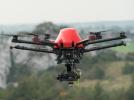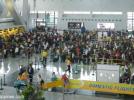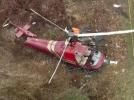Virgin Atlantic B744 over Atlantic on Nov 14th 2013, turbulence injures 4
A Virgin Atlantic Boeing 747-400, registration G-VLIP performing flight VS-66 (dep Nov 13th) from Montego Bay (Jamaica) to London Gatwick,EN (UK), was enroute about 300nm southeast of St. John's,NL (Canada) at about 04:05Z when the aircraft encountered turbulence causing injuries to 4 occupants. The aircraft continued to London for a safe landing about 4.5 hours later.
The FAA reported that one member of the flight crew and 3 passengers, but no cabin crew, were injured in the turbulence encounter.
On Sep 11th 2014 the British AAIB released their bulletin reporting the captain's (43, ATPL, 11,072 hours total, 7,853 hours on type) weather radar was tilted one degree down, the first officer's weather radar 2 degrees down. The radar screens painted light to moderate weather returns indicating a line of weather across the aircraft's track. The flight crew requested a deviation to the left, which was not approved, however a deviation to the right was approved. The AAIB stated: "The wind at this stage was from astern, so the crew were not concerned that their new track would be downwind of the observed weather and thus possibly subject to turbulence. As the aircraft flew abeam the line of weather, returns on the radar reduced and disappeared altogether."
The aircraft was still flying in smooth air and was instructed to descend to FL360 when "the aircraft started to encounter turbulence and the flight crew switched the cabin seat belt signs on. The commander recalled seeing a flash outside, which he thought may have been lightning associated with a thunderstorm cell beneath the aircraft. Suddenly, the turbulence increased markedly and became severe for a while. The flight crew felt that the aircraft climbed suddenly, and there was a brief activation of the stick shaker, although attitude remained normal and the autopilot and autothrottle remained engaged (the latter requiring some manual inputs to avoid exaggerated throttle position changes). Engine ignition systems were turned on as a precaution."
The captain, following the earlier ATC instruction, commenced a slow descent to FL360, the "aircraft attitude remained within normal values, although the vertical speed showed significant momentary climbs and descents."
The crew was subsequently informed a number of passengers and a cabin crew had received injuries, the most severe being a laceration injury to a passenger's knee. After consultation with medical advisors the crew decided to continue to Gatwick, where two passengers and the flight attendant were taken to a hospital.
Flight attendants reported that they were flying in smooth air, meal service had just been finished, most passengers were seated, when a light rumble occurred and the fasten seat belt signs illuminated. The flight attendant in the forward rather small cabin was able to complete checks of passenger seat belts, while taking her seat the turbulence increased in severity, she had difficulty to close her harness when a large jolt occurred. Another flight attendant further aft made a passenger announcement and spotting that the turbulence increased in severity added that all flight attendants should take their seats. As she sat down a substantial jolt occurred. The AAIB summarized: "The cabin crew reported that, because of the recent cabin service and the stage of flight, most passengers were already seated with their seat belts fastened. All the passengers who suffered injury were in the rear right side of the aircraft. The cabin crew member who suffered a head/neck injury was on a horizontal bunk in the crew rest area, which was also at the rear right."
According to the flight data recorder the flight had been smooth at FL370 when light turbulence set in. 9 minutes later a marked increase in turbulence occurred, the aircraft began to descend almost at the same time. About two minutes after the start of descent a peak acceleration occurred involving values of -0.7G and +1.7G. The aircraft subsequently levelled at FL360 and continued at FL360 for about 5 minutes flying in moderate turbulence, then climbed back to FL370 where turbulence significantly decreased, light turbulence was felt for another 15 minutes before turbulence subsided.
Infrared Satellite Image GOES-E Nov 14th 2013 02:45Z (Graphics: AVH/NASA):
http://avherald.com/h?article=46b79207














Komentarze